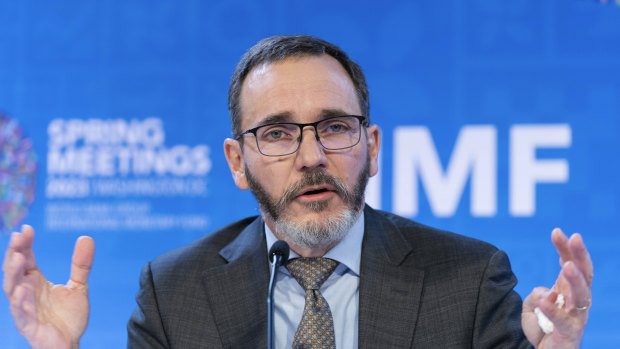‘Running to stand still’: Australians working extra long hours as economy slows
Save articles for later
Add articles to your saved list and come back to them any time.
Economic growth will slump over the next 12 months, with the nation’s home buyers struggling under the largest hit to their incomes in the developed world and warnings that Australians are working extra long hours to survive the soaring cost of living.
In what is shaping as a political challenge for the Albanese government, on Tuesday the International Monetary Fund downgraded its outlook for the Australian economy, forecasting it to expand by a modest 1.8 per cent this year and just 1.2 per cent in 2024.
High interest rates mean Australian home buyers are suffering the biggest hit to their incomes in the world, according to new IMF research.Credit: Rhett Wyman
Separate research by the Productivity Commission revealed Australians were sharply increasing their working hours, which was driving down overall productivity across the economy.
Commission acting chair Alex Robson said despite very low unemployment, over recent months Australians had lifted their working hours by the most on record outside the COVID-era disruption to work patterns.
“Productivity growth is about working smarter, not working longer or working harder. Negative productive growth means that on average, Australians worked more hours just to produce and buy the same amount of goods and services,” he said.
“In other words, Australians have been running to stand still.”
The IMF used its updated World Economic Outlook to slightly downgrade its expectations for global growth. It is forecasting global GDP to expand by 3 per cent this year and 2.9 per cent in 2024, well below the long-term average.
In Australia, the forecast slowdown in growth will be accompanied by a drop in inflation, which is tipped to average 5.8 per cent this year and 4 per cent in 2024.
The IMF’s forecasts for inflation are in line with those of the Reserve Bank and federal Treasury, but its outlook for growth is softer than both institutions’ views. Once population growth, which has reached 2.2 per cent, is taken into account, the IMF forecasts suggest an ongoing per capita recession in Australia.
A key factor in the slowdown is the impact of the Reserve Bank’s aggressive tightening of monetary policy, from 0.1 per cent at the start of May last year to 4.1 per cent now.
According to IMF research, Australians’ mortgage repayments by the end of last year consumed the largest share of household income of any country in the developed world. Since then, interest rates have pushed up even higher.
High mortgage repayments – and the prospect of them getting larger – continue to concern consumers. The Westpac-Melbourne Institute monthly measure of sentiment rose in October, although it remains at a very low level.
Westpac senior economist Matthew Hassan said the measure was still at a level consistent with further falls in spending per person.
The IMF estimates almost 16 per cent of household income is now eaten up by mortgage payments. By contrast, American households are paying less than 10 per cent of their income to lenders despite official interest rates in the United States being higher than in Australia.
The IMF’s economic counsellor, Pierre-Olivier Gourinchas, said the global economy was still recovering from the COVID-19 pandemic, Russia’s invasion of Ukraine and the cost of living crisis.
IMF economic counsellor Pierre-Olivier Gourinchas says the global economy is continuing to slow.Credit: AP
It had shown remarkable economic resilience, with low unemployment in many countries, which had increased real wages but led to a wage-price spiral.
“Even so, growth remains slow and uneven, with widening divergences. The global economy is limping along, not sprinting,” he said.
Gourinchas said risks remained tilted to the downside, with one of the biggest threats being a deterioration in China’s real estate sector. Another emerging concern was volatility in commodity prices, which would flow through to nations heavily dependent on resource exports, such as Australia.
Treasurer Jim Chalmers said the report confirmed the global headwinds that were affecting the Australian economy.
“The property sector crisis in China, high inflation and higher interest rates are all weighing on the global economy and will inevitably contribute to slower growth and weaker employment outcomes in Australia over the year ahead,” he said.
A key concern of the IMF remains finding new avenues to lift productivity growth, which has slipped in almost every country since just before the global financial crisis in 2008.
The Productivity Commission said productivity in Australia had fallen 2 per cent in the three months to the end of June, with declines in 15 of the 19 industries it monitored.
Across the arts and recreation sector, productivity slipped 7.6 per cent, with hours worked up by 9.3 per cent but output rising by 0.9 per cent. One-third of the drop in productivity was due to the mining sector, where adverse weather and planned maintenance reduced iron ore, oil and gas production.
Robson said apart from people working longer hours to offset the impact of high inflation, the tight jobs market had increased the number of people in the overall workforce while the end of COVID-19 restrictions had enabled workers to return to the office.
He said there had to be an increase in investment to help boost overall production.
“Our productivity challenge has been urgent for many years. We will only see sustainable, long-
term productivity growth if we increase investment and innovation,” he said.
Cut through the noise of federal politics with news, views and expert analysis. Subscribers can sign up to our weekly Inside Politics newsletter.
Most Viewed in Politics
From our partners
Source: Read Full Article

